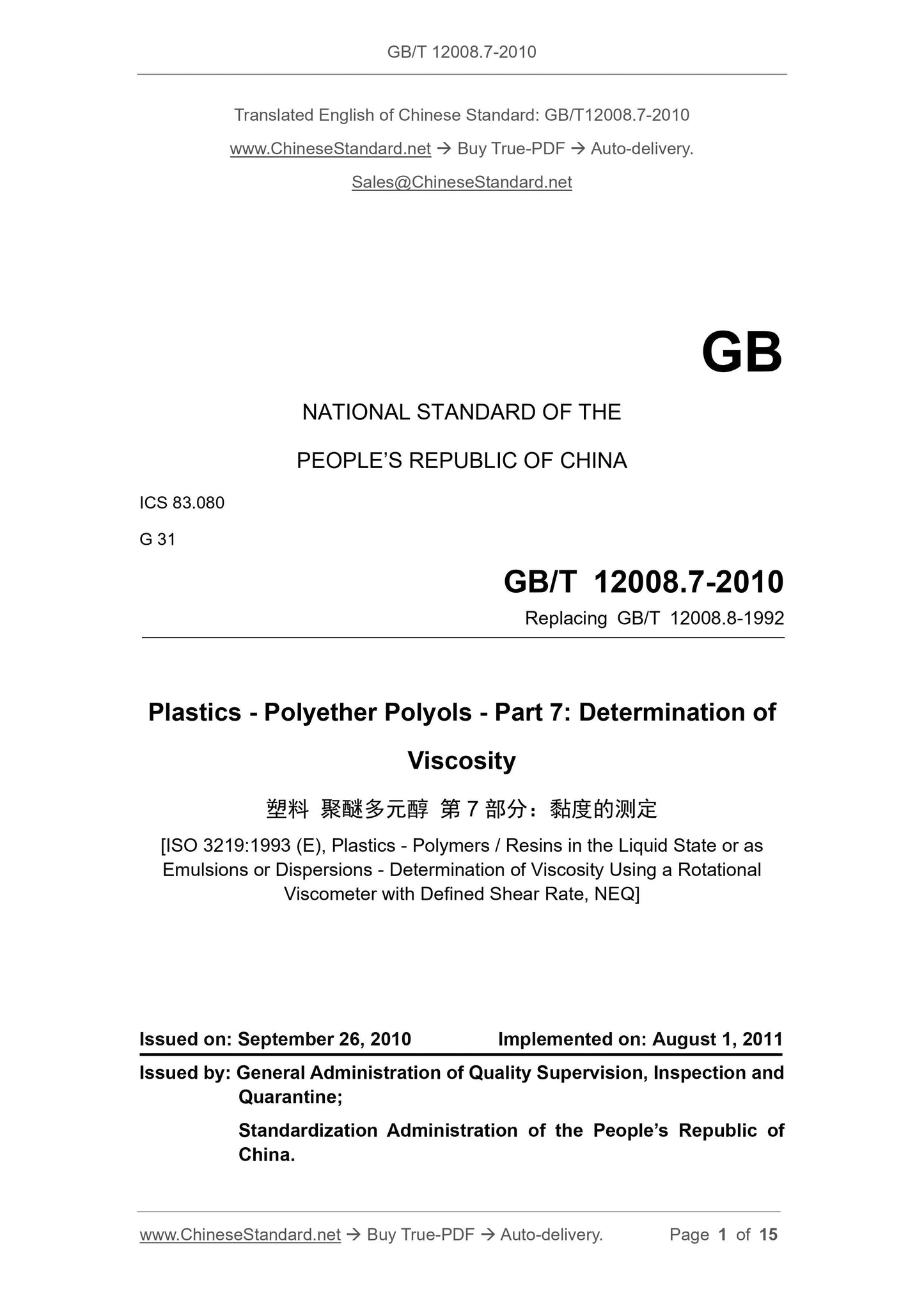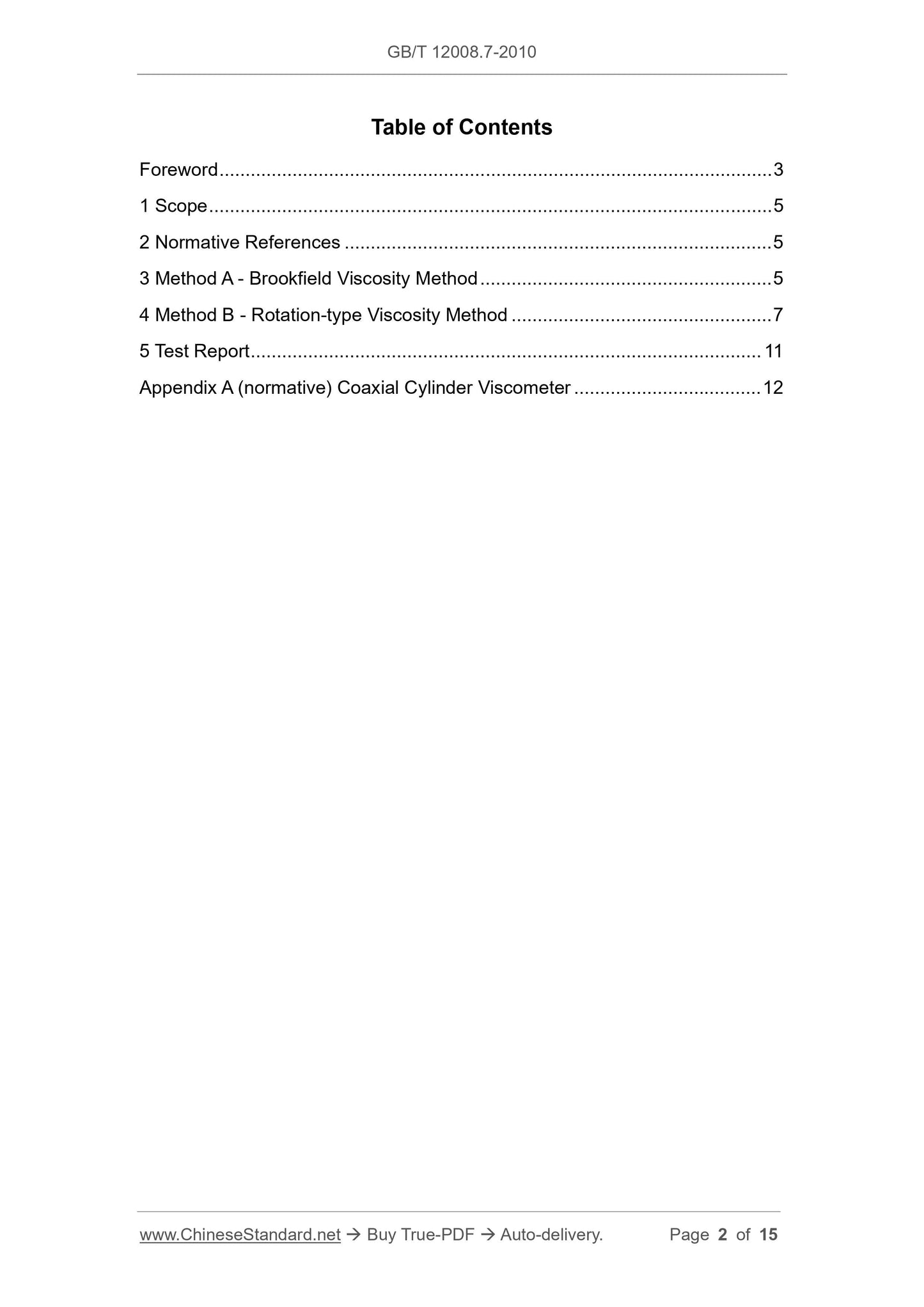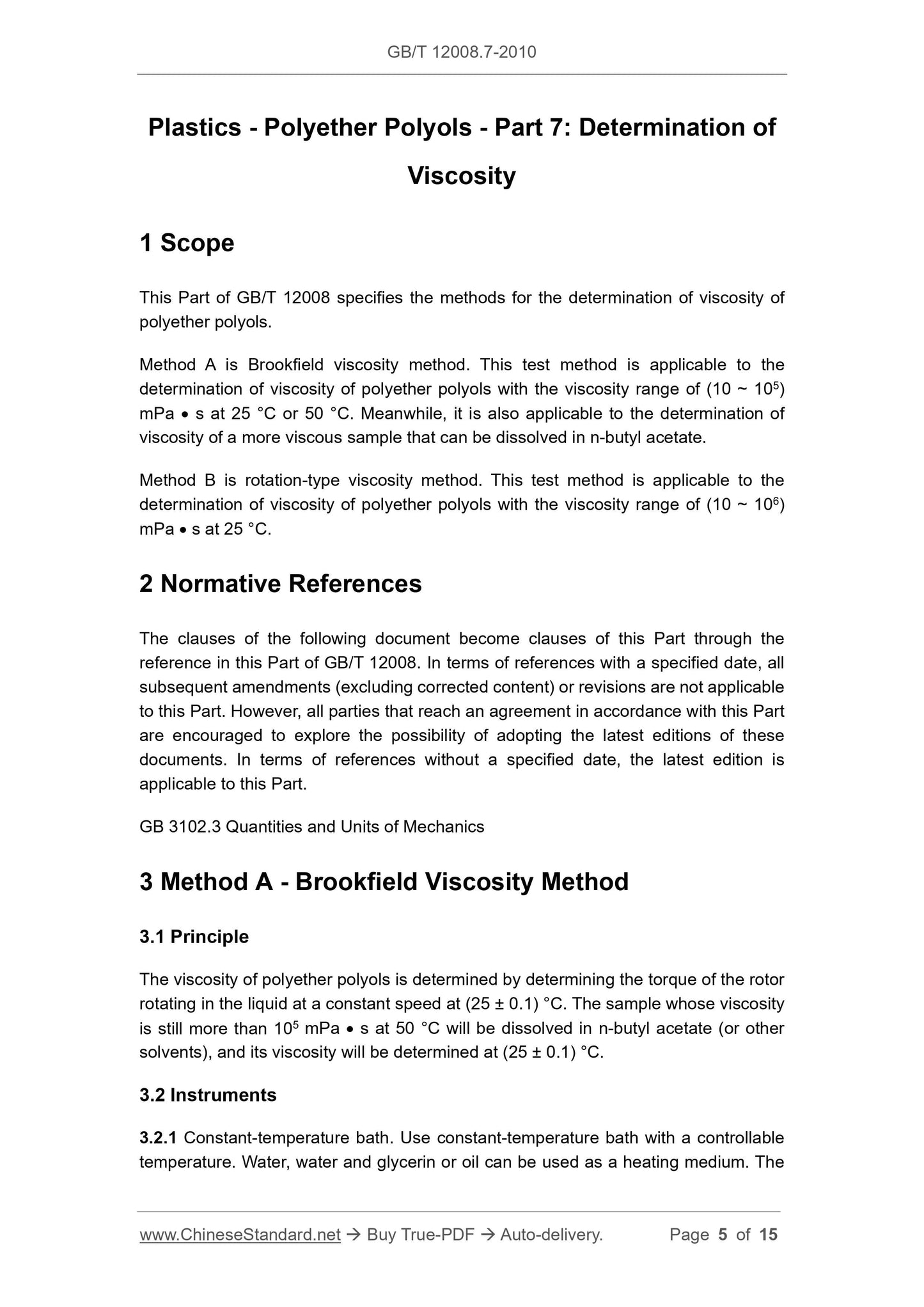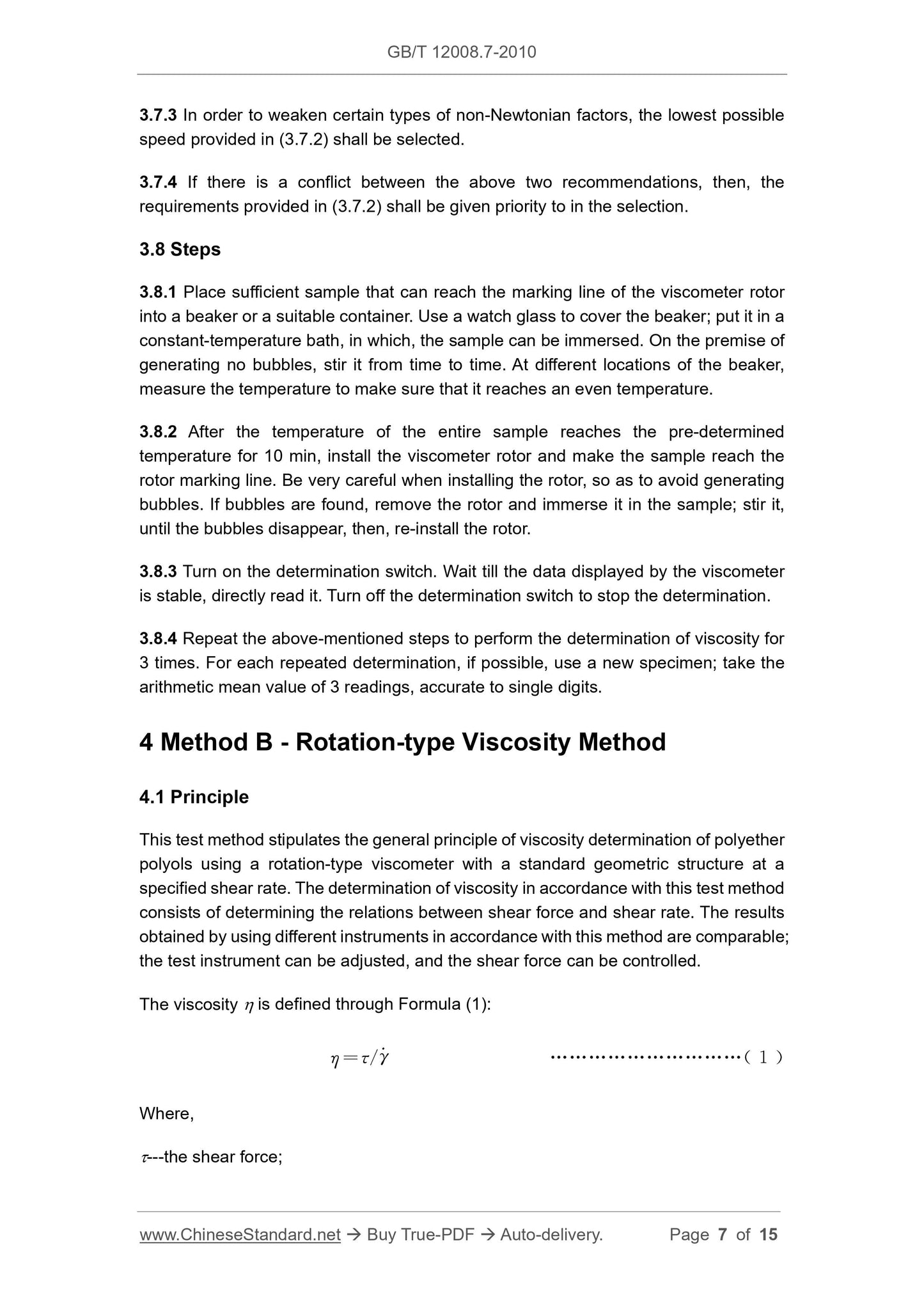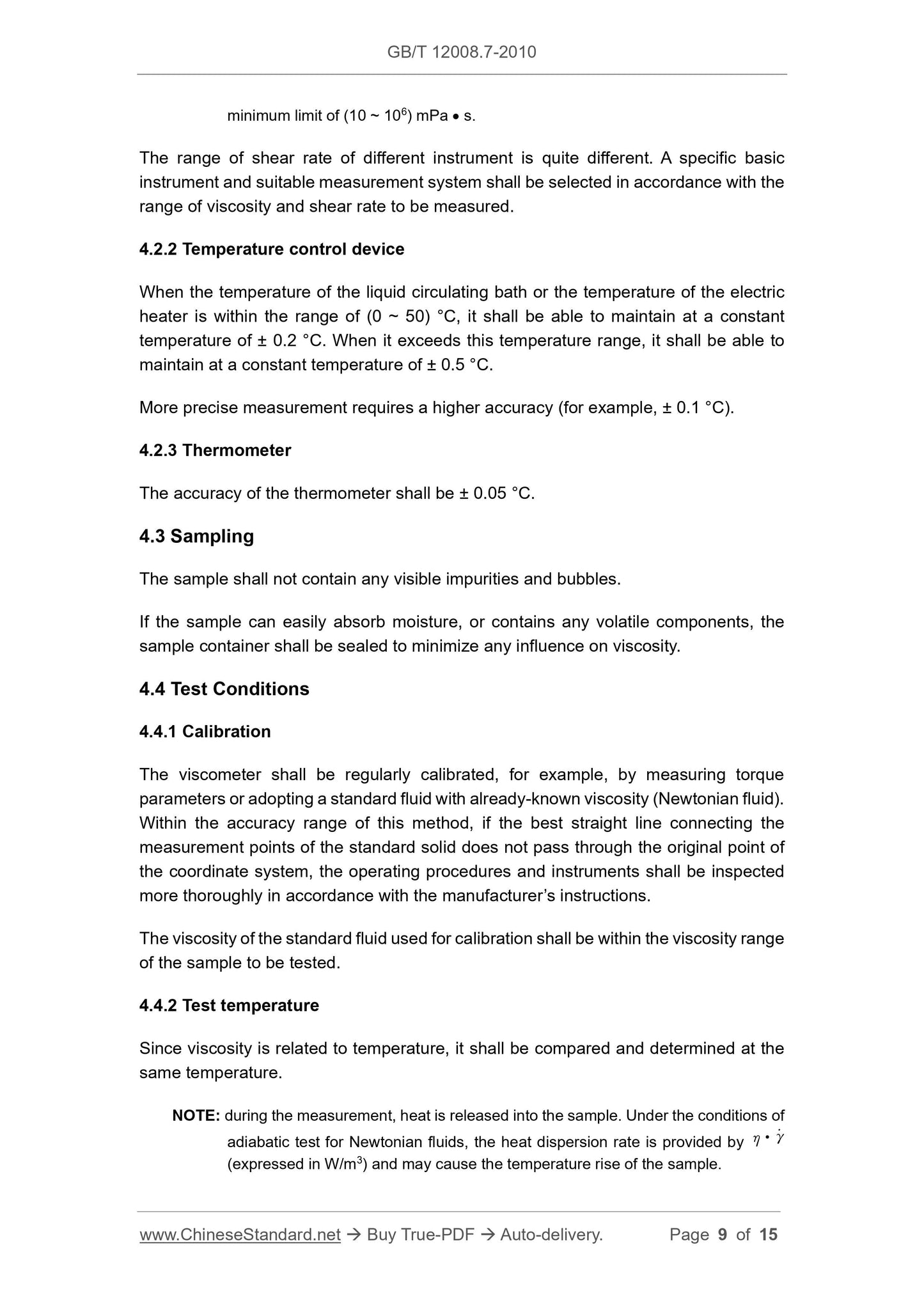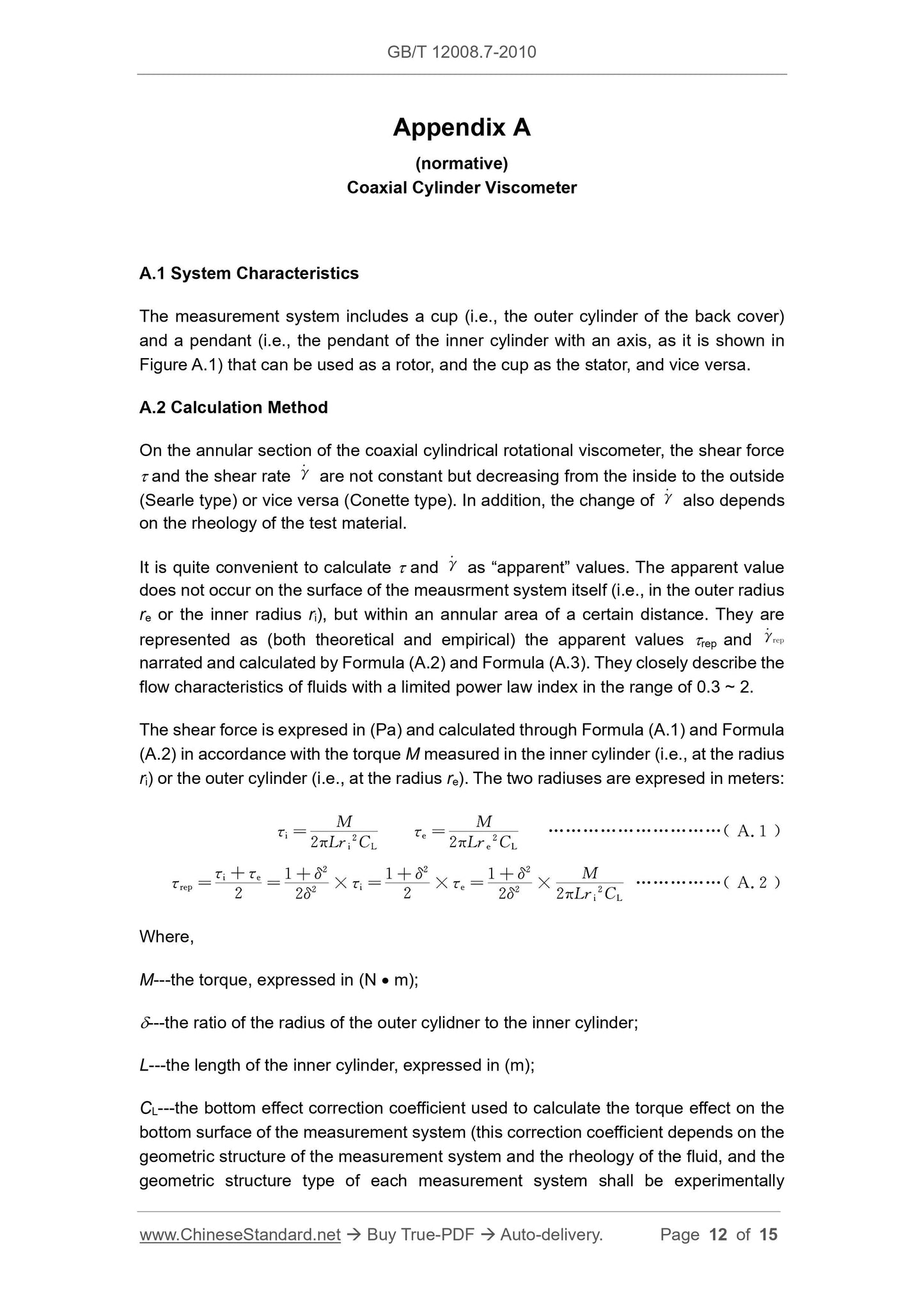NaN
/
of
-Infinity
www.ChineseStandard.us -- Field Test Asia Pte. Ltd.
GB/T 12008.7-2010 English PDF (GB/T12008.7-2010)
GB/T 12008.7-2010 English PDF (GB/T12008.7-2010)
Regular price
$190.00
Regular price
Sale price
$190.00
Unit price
/
per
Shipping calculated at checkout.
Couldn't load pickup availability
GB/T 12008.7-2010: Plastics -- Polyether polyols -- Part 7: Determination of viscosity
Delivery: 9 seconds. Download (& Email) true-PDF + Invoice.
Get Quotation: Click GB/T 12008.7-2010 (Self-service in 1-minute)
Historical versions (Master-website): GB/T 12008.7-2010
Preview True-PDF (Reload/Scroll-down if blank)
GB/T 12008.7-2010
GB
NATIONAL STANDARD OF THE
PEOPLE’S REPUBLIC OF CHINA
ICS 83.080
G 31
Replacing GB/T 12008.8-1992
Plastics - Polyether Polyols - Part 7: Determination of
Viscosity
[ISO 3219:1993 (E), Plastics - Polymers / Resins in the Liquid State or as
Emulsions or Dispersions - Determination of Viscosity Using a Rotational
Viscometer with Defined Shear Rate, NEQ]
ISSUED ON: SEPTEMBER 26, 2010
IMPLEMENTED ON: AUGUST 1, 2011
Issued by: General Administration of Quality Supervision, Inspection and
Quarantine;
Standardization Administration of the People’s Republic of
China.
Table of Contents
Foreword ... 3
1 Scope ... 5
2 Normative References ... 5
3 Method A - Brookfield Viscosity Method ... 5
4 Method B - Rotation-type Viscosity Method ... 7
5 Test Report ... 11
Appendix A (normative) Coaxial Cylinder Viscometer ... 12
Plastics - Polyether Polyols - Part 7: Determination of
Viscosity
1 Scope
This Part of GB/T 12008 specifies the methods for the determination of viscosity of
polyether polyols.
Method A is Brookfield viscosity method. This test method is applicable to the
determination of viscosity of polyether polyols with the viscosity range of (10 ~ 105)
mPa s at 25 °C or 50 °C. Meanwhile, it is also applicable to the determination of
viscosity of a more viscous sample that can be dissolved in n-butyl acetate.
Method B is rotation-type viscosity method. This test method is applicable to the
determination of viscosity of polyether polyols with the viscosity range of (10 ~ 106)
mPa s at 25 °C.
2 Normative References
The clauses of the following document become clauses of this Part through the
reference in this Part of GB/T 12008. In terms of references with a specified date, all
subsequent amendments (excluding corrected content) or revisions are not applicable
to this Part. However, all parties that reach an agreement in accordance with this Part
are encouraged to explore the possibility of adopting the latest editions of these
documents. In terms of references without a specified date, the latest edition is
applicable to this Part.
GB 3102.3 Quantities and Units of Mechanics
3 Method A - Brookfield Viscosity Method
3.1 Principle
The viscosity of polyether polyols is determined by determining the torque of the rotor
rotating in the liquid at a constant speed at (25 ± 0.1) °C. The sample whose viscosity
is still more than 105 mPa s at 50 °C will be dissolved in n-butyl acetate (or other
solvents), and its viscosity will be determined at (25 ± 0.1) °C.
3.2 Instruments
3.2.1 Constant-temperature bath. Use constant-temperature bath with a controllable
temperature. Water, water and glycerin or oil can be used as a heating medium. The
3.7.3 In order to weaken certain types of non-Newtonian factors, the lowest possible
speed provided in (3.7.2) shall be selected.
3.7.4 If there is a conflict between the above two recommendations, then, the
requirements provided in (3.7.2) shall be given priority to in the selection.
3.8 Steps
3.8.1 Place sufficient sample that can reach the marking line of the viscometer rotor
into a beaker or a suitable container. Use a watch glass to cover the beaker; put it in a
constant-temperature bath, in which, the sample can be immersed. On the premise of
generating no bubbles, stir it from time to time. At different locations of the beaker,
measure the temperature to make sure that it reaches an even temperature.
3.8.2 After the temperature of the entire sample reaches the pre-determined
temperature for 10 min, install the viscometer rotor and make the sample reach the
rotor marking line. Be very careful when installing the rotor, so as to avoid generating
bubbles. If bubbles are found, remove the rotor and immerse it in the sample; stir it,
until the bubbles disappear, then, re-install the rotor.
3.8.3 Turn on the determination switch. Wait till the data displayed by the viscometer
is stable, directly read it. Turn off the determination switch to stop the determination.
3.8.4 Repeat the above-mentioned steps to perform the determination of viscosity for
3 times. For each repeated determination, if possible, use a new specimen; take the
arithmetic mean value of 3 readings, accurate to single digits.
4 Method B - Rotation-type Viscosity Method
4.1 Principle
This test method stipulates the general principle of viscosity determination of polyether
polyols using a rotation-type viscometer with a standard geometric structure at a
specified shear rate. The determination of viscosity in accordance with this test method
consists of determining the relations between shear force and shear rate. The results
obtained by using different instruments in accordance with this method are comparable;
the test instrument can be adjusted, and the shear force can be controlled.
The viscosity is defined through Formula (1):
Where,
---the shear force;
minimum limit of (10 ~ 106) mPa s.
The range of shear rate of different instrument is quite different. A specific basic
instrument and suitable measurement system shall be selected in accordance with the
range of viscosity and shear rate to be measured.
4.2.2 Temperature control device
When the temperature of the liquid circulating bath or the temperature of the electric
heater is within the range of (0 ~ 50) °C, it shall be able to maintain at a constant
temperature of ± 0.2 °C. When it exceeds this temperature range, it shall be able to
maintain at a constant temperature of ± 0.5 °C.
More precise measurement requires a higher accuracy (for example, ± 0.1 °C).
4.2.3 Thermometer
The accuracy of the thermometer shall be ± 0.05 °C.
4.3 Sampling
The sample shall not contain any visible impurities and bubbles.
If the sample can easily absorb moisture, or contains any volatile components, the
sample container shall be sealed to minimize any influence on viscosity.
4.4 Test Conditions
4.4.1 Calibration
The viscometer shall be regularly calibrated, for example, by measuring torque
parameters or adopting a standard fluid with already-known viscosity (Newtonian fluid).
Within the accuracy range of this method, if the best straight line connecting the
measurement points of the standard solid does not pass through the original point of
the coordinate system, the operating procedures and instruments shall be inspected
more thoroughly in accordance with the manufacturer’s instructions.
The viscosity of the standard fluid used for calibration shall be within the viscosity range
of the sample to be tested.
4.4.2 Test temperature
Since viscosity is related to temperature, it shall be compared and determined at the
same temperature.
NOTE: during the measurement, heat is released into the sample. Under the conditions of
adiabatic test for Newtonian fluids, the heat dispersion rate is provided by
(expressed in W/m3) and may cause the temperature rise of the sample.
Appendix A
(normative)
Coaxial Cylinder Viscometer
A.1 System Characteristics
The measurement system includes a cup (i.e., the outer cylinder of the back cover)
and a pendant (i.e., the pendant of the inner cylinder with an axis, as it is shown in
Figure A.1) that can be used as a rotor, and the cup as the stator, and vice versa.
A.2 Calculation Method
On the annular section of the coaxial cylindrical rotational viscometer, the shear force
and the shear rate are not constant but decreasing from the inside to the outside
(Searle type) or vice versa (Conette type). In addition, the change of also depends
on the rheology of the test material.
It is quite convenient to calculate and as “apparent” values. The apparent value
does not occur on the surface of the meausrment system itself (i.e., in the outer radius
re or the inner radius ri), but within an annular area of a certain distance. They are
represented as (both theoretical and empirical) the apparent values rep and
narrated and calculated by Formula (A.2) and Formula (A.3). They closely describe the
flow characteristics of fluids with a limited power law index in the range of 0.3 ~ 2.
The shear force is expresed in (Pa) and calculated through Formula (A.1) and Formula
(A.2) in accordance with the torque M measured in the inner cylinder (i.e., at the radius
ri) or the outer cylinder (i.e., at the radius re). The two radiuses are expresed in meters:
Where,
M---the torque, expressed in (N m);
---the ratio of the radius of the outer cylidner to the inner cylinder;
L---the length of the inner cylinder, expressed in (m);
CL---the bottom effect correction coefficient used to calculate the torque effect on the
bottom surface of the measurement system (this correction coefficient depends on the
geometric structure of the measurement system and the rheology of the fluid, and the
geometric structure type of each measurement system shall be experimentally
GB/T 12008.7-2010
GB
NATIONAL STANDARD OF THE
PEOPLE’S REPUBLIC OF CHINA
ICS 83.080
G 31
Replacing GB/T 12008.8-1992
Plastics - Polyether Polyols - Part 7: Determination of
Viscosity
[ISO 3219:1993 (E), Plastics - Polymers / Resins in the Liquid State or as
Emulsions or Dispersions - Determination of Viscosity Using a Rotational
Viscometer with Defined Shear Rate, NEQ]
ISSUED ON: SEPTEMBER 26, 2010
IMPLEMENTED ON: AUGUST 1, 2011
Issued by: General Administration of Quality Supervision, Inspection and
Quarantine;
Standardization Administration of the People’s Republic of
China.
Table of Contents
Foreword ... 3
1 Scope ... 5
2 Normative References ... 5
3 Method A - Brookfield Viscosity Method ... 5
4 Method B - Rotation-type Viscosity Method ... 7
5 Test Report ... 11
Appendix A (normative) Coaxial Cylinder Viscometer ... 12
Plastics - Polyether Polyols - Part 7: Determination of
Viscosity
1 Scope
This Part of GB/T 12008 specifies the methods for the determination of viscosity of
polyether polyols.
Method A is Brookfield viscosity method. This test method is applicable to the
determination of viscosity of polyether polyols with the viscosity range of (10 ~ 105)
mPa s at 25 °C or 50 °C. Meanwhile, it is also applicable to the determination of
viscosity of a more viscous sample that can be dissolved in n-butyl acetate.
Method B is rotation-type viscosity method. This test method is applicable to the
determination of viscosity of polyether polyols with the viscosity range of (10 ~ 106)
mPa s at 25 °C.
2 Normative References
The clauses of the following document become clauses of this Part through the
reference in this Part of GB/T 12008. In terms of references with a specified date, all
subsequent amendments (excluding corrected content) or revisions are not applicable
to this Part. However, all parties that reach an agreement in accordance with this Part
are encouraged to explore the possibility of adopting the latest editions of these
documents. In terms of references without a specified date, the latest edition is
applicable to this Part.
GB 3102.3 Quantities and Units of Mechanics
3 Method A - Brookfield Viscosity Method
3.1 Principle
The viscosity of polyether polyols is determined by determining the torque of the rotor
rotating in the liquid at a constant speed at (25 ± 0.1) °C. The sample whose viscosity
is still more than 105 mPa s at 50 °C will be dissolved in n-butyl acetate (or other
solvents), and its viscosity will be determined at (25 ± 0.1) °C.
3.2 Instruments
3.2.1 Constant-temperature bath. Use constant-temperature bath with a controllable
temperature. Water, water and glycerin or oil can be used as a heating medium. The
3.7.3 In order to weaken certain types of non-Newtonian factors, the lowest possible
speed provided in (3.7.2) shall be selected.
3.7.4 If there is a conflict between the above two recommendations, then, the
requirements provided in (3.7.2) shall be given priority to in the selection.
3.8 Steps
3.8.1 Place sufficient sample that can reach the marking line of the viscometer rotor
into a beaker or a suitable container. Use a watch glass to cover the beaker; put it in a
constant-temperature bath, in which, the sample can be immersed. On the premise of
generating no bubbles, stir it from time to time. At different locations of the beaker,
measure the temperature to make sure that it reaches an even temperature.
3.8.2 After the temperature of the entire sample reaches the pre-determined
temperature for 10 min, install the viscometer rotor and make the sample reach the
rotor marking line. Be very careful when installing the rotor, so as to avoid generating
bubbles. If bubbles are found, remove the rotor and immerse it in the sample; stir it,
until the bubbles disappear, then, re-install the rotor.
3.8.3 Turn on the determination switch. Wait till the data displayed by the viscometer
is stable, directly read it. Turn off the determination switch to stop the determination.
3.8.4 Repeat the above-mentioned steps to perform the determination of viscosity for
3 times. For each repeated determination, if possible, use a new specimen; take the
arithmetic mean value of 3 readings, accurate to single digits.
4 Method B - Rotation-type Viscosity Method
4.1 Principle
This test method stipulates the general principle of viscosity determination of polyether
polyols using a rotation-type viscometer with a standard geometric structure at a
specified shear rate. The determination of viscosity in accordance with this test method
consists of determining the relations between shear force and shear rate. The results
obtained by using different instruments in accordance with this method are comparable;
the test instrument can be adjusted, and the shear force can be controlled.
The viscosity is defined through Formula (1):
Where,
---the shear force;
minimum limit of (10 ~ 106) mPa s.
The range of shear rate of different instrument is quite different. A specific basic
instrument and suitable measurement system shall be select...
Delivery: 9 seconds. Download (& Email) true-PDF + Invoice.
Get Quotation: Click GB/T 12008.7-2010 (Self-service in 1-minute)
Historical versions (Master-website): GB/T 12008.7-2010
Preview True-PDF (Reload/Scroll-down if blank)
GB/T 12008.7-2010
GB
NATIONAL STANDARD OF THE
PEOPLE’S REPUBLIC OF CHINA
ICS 83.080
G 31
Replacing GB/T 12008.8-1992
Plastics - Polyether Polyols - Part 7: Determination of
Viscosity
[ISO 3219:1993 (E), Plastics - Polymers / Resins in the Liquid State or as
Emulsions or Dispersions - Determination of Viscosity Using a Rotational
Viscometer with Defined Shear Rate, NEQ]
ISSUED ON: SEPTEMBER 26, 2010
IMPLEMENTED ON: AUGUST 1, 2011
Issued by: General Administration of Quality Supervision, Inspection and
Quarantine;
Standardization Administration of the People’s Republic of
China.
Table of Contents
Foreword ... 3
1 Scope ... 5
2 Normative References ... 5
3 Method A - Brookfield Viscosity Method ... 5
4 Method B - Rotation-type Viscosity Method ... 7
5 Test Report ... 11
Appendix A (normative) Coaxial Cylinder Viscometer ... 12
Plastics - Polyether Polyols - Part 7: Determination of
Viscosity
1 Scope
This Part of GB/T 12008 specifies the methods for the determination of viscosity of
polyether polyols.
Method A is Brookfield viscosity method. This test method is applicable to the
determination of viscosity of polyether polyols with the viscosity range of (10 ~ 105)
mPa s at 25 °C or 50 °C. Meanwhile, it is also applicable to the determination of
viscosity of a more viscous sample that can be dissolved in n-butyl acetate.
Method B is rotation-type viscosity method. This test method is applicable to the
determination of viscosity of polyether polyols with the viscosity range of (10 ~ 106)
mPa s at 25 °C.
2 Normative References
The clauses of the following document become clauses of this Part through the
reference in this Part of GB/T 12008. In terms of references with a specified date, all
subsequent amendments (excluding corrected content) or revisions are not applicable
to this Part. However, all parties that reach an agreement in accordance with this Part
are encouraged to explore the possibility of adopting the latest editions of these
documents. In terms of references without a specified date, the latest edition is
applicable to this Part.
GB 3102.3 Quantities and Units of Mechanics
3 Method A - Brookfield Viscosity Method
3.1 Principle
The viscosity of polyether polyols is determined by determining the torque of the rotor
rotating in the liquid at a constant speed at (25 ± 0.1) °C. The sample whose viscosity
is still more than 105 mPa s at 50 °C will be dissolved in n-butyl acetate (or other
solvents), and its viscosity will be determined at (25 ± 0.1) °C.
3.2 Instruments
3.2.1 Constant-temperature bath. Use constant-temperature bath with a controllable
temperature. Water, water and glycerin or oil can be used as a heating medium. The
3.7.3 In order to weaken certain types of non-Newtonian factors, the lowest possible
speed provided in (3.7.2) shall be selected.
3.7.4 If there is a conflict between the above two recommendations, then, the
requirements provided in (3.7.2) shall be given priority to in the selection.
3.8 Steps
3.8.1 Place sufficient sample that can reach the marking line of the viscometer rotor
into a beaker or a suitable container. Use a watch glass to cover the beaker; put it in a
constant-temperature bath, in which, the sample can be immersed. On the premise of
generating no bubbles, stir it from time to time. At different locations of the beaker,
measure the temperature to make sure that it reaches an even temperature.
3.8.2 After the temperature of the entire sample reaches the pre-determined
temperature for 10 min, install the viscometer rotor and make the sample reach the
rotor marking line. Be very careful when installing the rotor, so as to avoid generating
bubbles. If bubbles are found, remove the rotor and immerse it in the sample; stir it,
until the bubbles disappear, then, re-install the rotor.
3.8.3 Turn on the determination switch. Wait till the data displayed by the viscometer
is stable, directly read it. Turn off the determination switch to stop the determination.
3.8.4 Repeat the above-mentioned steps to perform the determination of viscosity for
3 times. For each repeated determination, if possible, use a new specimen; take the
arithmetic mean value of 3 readings, accurate to single digits.
4 Method B - Rotation-type Viscosity Method
4.1 Principle
This test method stipulates the general principle of viscosity determination of polyether
polyols using a rotation-type viscometer with a standard geometric structure at a
specified shear rate. The determination of viscosity in accordance with this test method
consists of determining the relations between shear force and shear rate. The results
obtained by using different instruments in accordance with this method are comparable;
the test instrument can be adjusted, and the shear force can be controlled.
The viscosity is defined through Formula (1):
Where,
---the shear force;
minimum limit of (10 ~ 106) mPa s.
The range of shear rate of different instrument is quite different. A specific basic
instrument and suitable measurement system shall be selected in accordance with the
range of viscosity and shear rate to be measured.
4.2.2 Temperature control device
When the temperature of the liquid circulating bath or the temperature of the electric
heater is within the range of (0 ~ 50) °C, it shall be able to maintain at a constant
temperature of ± 0.2 °C. When it exceeds this temperature range, it shall be able to
maintain at a constant temperature of ± 0.5 °C.
More precise measurement requires a higher accuracy (for example, ± 0.1 °C).
4.2.3 Thermometer
The accuracy of the thermometer shall be ± 0.05 °C.
4.3 Sampling
The sample shall not contain any visible impurities and bubbles.
If the sample can easily absorb moisture, or contains any volatile components, the
sample container shall be sealed to minimize any influence on viscosity.
4.4 Test Conditions
4.4.1 Calibration
The viscometer shall be regularly calibrated, for example, by measuring torque
parameters or adopting a standard fluid with already-known viscosity (Newtonian fluid).
Within the accuracy range of this method, if the best straight line connecting the
measurement points of the standard solid does not pass through the original point of
the coordinate system, the operating procedures and instruments shall be inspected
more thoroughly in accordance with the manufacturer’s instructions.
The viscosity of the standard fluid used for calibration shall be within the viscosity range
of the sample to be tested.
4.4.2 Test temperature
Since viscosity is related to temperature, it shall be compared and determined at the
same temperature.
NOTE: during the measurement, heat is released into the sample. Under the conditions of
adiabatic test for Newtonian fluids, the heat dispersion rate is provided by
(expressed in W/m3) and may cause the temperature rise of the sample.
Appendix A
(normative)
Coaxial Cylinder Viscometer
A.1 System Characteristics
The measurement system includes a cup (i.e., the outer cylinder of the back cover)
and a pendant (i.e., the pendant of the inner cylinder with an axis, as it is shown in
Figure A.1) that can be used as a rotor, and the cup as the stator, and vice versa.
A.2 Calculation Method
On the annular section of the coaxial cylindrical rotational viscometer, the shear force
and the shear rate are not constant but decreasing from the inside to the outside
(Searle type) or vice versa (Conette type). In addition, the change of also depends
on the rheology of the test material.
It is quite convenient to calculate and as “apparent” values. The apparent value
does not occur on the surface of the meausrment system itself (i.e., in the outer radius
re or the inner radius ri), but within an annular area of a certain distance. They are
represented as (both theoretical and empirical) the apparent values rep and
narrated and calculated by Formula (A.2) and Formula (A.3). They closely describe the
flow characteristics of fluids with a limited power law index in the range of 0.3 ~ 2.
The shear force is expresed in (Pa) and calculated through Formula (A.1) and Formula
(A.2) in accordance with the torque M measured in the inner cylinder (i.e., at the radius
ri) or the outer cylinder (i.e., at the radius re). The two radiuses are expresed in meters:
Where,
M---the torque, expressed in (N m);
---the ratio of the radius of the outer cylidner to the inner cylinder;
L---the length of the inner cylinder, expressed in (m);
CL---the bottom effect correction coefficient used to calculate the torque effect on the
bottom surface of the measurement system (this correction coefficient depends on the
geometric structure of the measurement system and the rheology of the fluid, and the
geometric structure type of each measurement system shall be experimentally
GB/T 12008.7-2010
GB
NATIONAL STANDARD OF THE
PEOPLE’S REPUBLIC OF CHINA
ICS 83.080
G 31
Replacing GB/T 12008.8-1992
Plastics - Polyether Polyols - Part 7: Determination of
Viscosity
[ISO 3219:1993 (E), Plastics - Polymers / Resins in the Liquid State or as
Emulsions or Dispersions - Determination of Viscosity Using a Rotational
Viscometer with Defined Shear Rate, NEQ]
ISSUED ON: SEPTEMBER 26, 2010
IMPLEMENTED ON: AUGUST 1, 2011
Issued by: General Administration of Quality Supervision, Inspection and
Quarantine;
Standardization Administration of the People’s Republic of
China.
Table of Contents
Foreword ... 3
1 Scope ... 5
2 Normative References ... 5
3 Method A - Brookfield Viscosity Method ... 5
4 Method B - Rotation-type Viscosity Method ... 7
5 Test Report ... 11
Appendix A (normative) Coaxial Cylinder Viscometer ... 12
Plastics - Polyether Polyols - Part 7: Determination of
Viscosity
1 Scope
This Part of GB/T 12008 specifies the methods for the determination of viscosity of
polyether polyols.
Method A is Brookfield viscosity method. This test method is applicable to the
determination of viscosity of polyether polyols with the viscosity range of (10 ~ 105)
mPa s at 25 °C or 50 °C. Meanwhile, it is also applicable to the determination of
viscosity of a more viscous sample that can be dissolved in n-butyl acetate.
Method B is rotation-type viscosity method. This test method is applicable to the
determination of viscosity of polyether polyols with the viscosity range of (10 ~ 106)
mPa s at 25 °C.
2 Normative References
The clauses of the following document become clauses of this Part through the
reference in this Part of GB/T 12008. In terms of references with a specified date, all
subsequent amendments (excluding corrected content) or revisions are not applicable
to this Part. However, all parties that reach an agreement in accordance with this Part
are encouraged to explore the possibility of adopting the latest editions of these
documents. In terms of references without a specified date, the latest edition is
applicable to this Part.
GB 3102.3 Quantities and Units of Mechanics
3 Method A - Brookfield Viscosity Method
3.1 Principle
The viscosity of polyether polyols is determined by determining the torque of the rotor
rotating in the liquid at a constant speed at (25 ± 0.1) °C. The sample whose viscosity
is still more than 105 mPa s at 50 °C will be dissolved in n-butyl acetate (or other
solvents), and its viscosity will be determined at (25 ± 0.1) °C.
3.2 Instruments
3.2.1 Constant-temperature bath. Use constant-temperature bath with a controllable
temperature. Water, water and glycerin or oil can be used as a heating medium. The
3.7.3 In order to weaken certain types of non-Newtonian factors, the lowest possible
speed provided in (3.7.2) shall be selected.
3.7.4 If there is a conflict between the above two recommendations, then, the
requirements provided in (3.7.2) shall be given priority to in the selection.
3.8 Steps
3.8.1 Place sufficient sample that can reach the marking line of the viscometer rotor
into a beaker or a suitable container. Use a watch glass to cover the beaker; put it in a
constant-temperature bath, in which, the sample can be immersed. On the premise of
generating no bubbles, stir it from time to time. At different locations of the beaker,
measure the temperature to make sure that it reaches an even temperature.
3.8.2 After the temperature of the entire sample reaches the pre-determined
temperature for 10 min, install the viscometer rotor and make the sample reach the
rotor marking line. Be very careful when installing the rotor, so as to avoid generating
bubbles. If bubbles are found, remove the rotor and immerse it in the sample; stir it,
until the bubbles disappear, then, re-install the rotor.
3.8.3 Turn on the determination switch. Wait till the data displayed by the viscometer
is stable, directly read it. Turn off the determination switch to stop the determination.
3.8.4 Repeat the above-mentioned steps to perform the determination of viscosity for
3 times. For each repeated determination, if possible, use a new specimen; take the
arithmetic mean value of 3 readings, accurate to single digits.
4 Method B - Rotation-type Viscosity Method
4.1 Principle
This test method stipulates the general principle of viscosity determination of polyether
polyols using a rotation-type viscometer with a standard geometric structure at a
specified shear rate. The determination of viscosity in accordance with this test method
consists of determining the relations between shear force and shear rate. The results
obtained by using different instruments in accordance with this method are comparable;
the test instrument can be adjusted, and the shear force can be controlled.
The viscosity is defined through Formula (1):
Where,
---the shear force;
minimum limit of (10 ~ 106) mPa s.
The range of shear rate of different instrument is quite different. A specific basic
instrument and suitable measurement system shall be select...






